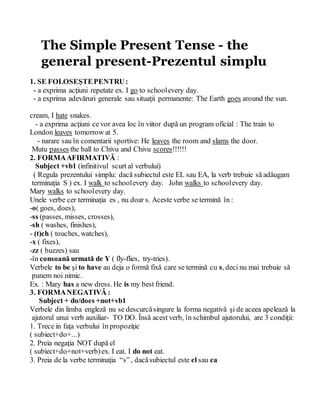The simple present tense
•Download as DOCX, PDF•
0 likes•366 views
The simple present tense
Report
Share
Report
Share

Recommended
More Related Content
Featured
Featured (20)
Product Design Trends in 2024 | Teenage Engineerings

Product Design Trends in 2024 | Teenage Engineerings
How Race, Age and Gender Shape Attitudes Towards Mental Health

How Race, Age and Gender Shape Attitudes Towards Mental Health
AI Trends in Creative Operations 2024 by Artwork Flow.pdf

AI Trends in Creative Operations 2024 by Artwork Flow.pdf
Content Methodology: A Best Practices Report (Webinar)

Content Methodology: A Best Practices Report (Webinar)
How to Prepare For a Successful Job Search for 2024

How to Prepare For a Successful Job Search for 2024
Social Media Marketing Trends 2024 // The Global Indie Insights

Social Media Marketing Trends 2024 // The Global Indie Insights
Trends In Paid Search: Navigating The Digital Landscape In 2024

Trends In Paid Search: Navigating The Digital Landscape In 2024
5 Public speaking tips from TED - Visualized summary

5 Public speaking tips from TED - Visualized summary
Google's Just Not That Into You: Understanding Core Updates & Search Intent

Google's Just Not That Into You: Understanding Core Updates & Search Intent
The six step guide to practical project management

The six step guide to practical project management
Beginners Guide to TikTok for Search - Rachel Pearson - We are Tilt __ Bright...

Beginners Guide to TikTok for Search - Rachel Pearson - We are Tilt __ Bright...
The simple present tense
- 1. The Simple Present Tense - the general present-Prezentul simplu 1. SE FOLOSEŞTEPENTRU: - a exprima acţiuni repetate ex. I go to schoolevery day. - a exprima adevăruri generale sau situaţii permanente: The Earth goes around the sun. cream, I hate snakes. - a exprima acţiuni ce vor avea loc în viitor după un program oficial : The train to London leaves tomorrow at 5. - narare sau în comentarii sportive: He leaves the room and slams the door. Mutu passes the ball to Chivu and Chivu scores!!!!!! 2. FORMAAFIRMATIVĂ : Subject +vb1 (infinitivul scurt al verbului) ( Regula prezentului simplu: dacă subiectul este EL sau EA, la verb trebuie să adăugam terminaţia S ) ex. I walk to schoolevery day. John walks to schoolevery day. Mary walks to schoolevery day. Unele verbe cer terminaţia es , nu doar s. Aceste verbe se termină în : -o( goes, does), -ss (passes, misses, crosses), -sh ( washes, finishes), - (t)ch ( touches, watches), -x ( fixes), -zz ( buzzes) sau -în consoană urmată de Y ( fly-flies, try-tries). Verbele to be şi to have au deja o formă fixă care se termină cu s, deci nu mai trebuie să punem noi nimic. Ex. : Mary has a new dress. He is my best friend. 3. FORMANEGATIVĂ : Subject + do/does +not+vb1 Verbele din limba engleză nu se descurcăsingure la forma negativă şi de aceea apelează la ajutorul unui verb auxiliar- TO DO. Însă acest verb, în schimbul ajutorului, are 3 condiţii: 1. Trece in faţa verbului în propoziţie ( subiect+do+...) 2. Preia negaţia NOT după el ( subiect+do+not+verb)ex. I eat. I do not eat. 3. Preia de la verbe terminaţia “s”, dacăsubiectul este el sau ea
- 2. ( subiect+does +not+verb)ex. I eat. Mary does not eat. Atenţie!!! Verbul TO BE nu acceptă ajutorul lui DO şi se descurcăsingur, cu propriile sale forme, la negativ ( Subject + am, are, is + not ). Ex. I am not your friend. 4. FORMAINTEROGATIVĂ: DO/DOES + subject+vb1 ? Şi la forma interogativă ( la intrebări), verbele apelează la ajutorul lui DO, care trece in faţa subiectului (are loc inversiunea subiectului cu verbul to do ): DO+subiect+vb1…? Ex: Do you speak English? DOES+subiect(el/ea)+vb1…? Ex: Does Mary speak English? Verbul TO BE se descurcă, din nou, singur, utiliyând formele sale proprii : AM/ARE/IS + subject ? ex. Are you my friend?